Researchers from the University of Illinois have identified a new, cheaper and easier way to detect methylation (alterations) of DNA. By measuring the methylation... Researchers from the University of Illinois have identified a new, cheaper and easier way to detect methylation (alterations) of DNA. By measuring the methylation of certain DNA sequences, doctors can predict the likelihood of cancers and other disorders. This early detection has the potential to save lives. |
Biosensors based on one- or two-dimensional photonic-crystal reflectance filters operating at near-ultraviolet wavelengths. The biosensors feature a tightly... Biosensors based on one- or two-dimensional photonic-crystal reflectance filters operating at near-ultraviolet wavelengths. The biosensors feature a tightly confined resonant electric field at the surface of this biosensor and provide a high surface-sensitivity to bulk-sensitivity ratio, enabling enhanced detection resolution for biomolecules adsorbed on the biosensor surface. These new biosensors can be fabricated in mass by replica molding and are especially well suited for applications requiring the detection of small molecules or ultra-low analyte concentrations. |
A biosensor based upon a vertically emitting, distributed feedback (DFB) laser. The DFB laser comprises a replica-molded, one- or two-dimensional dielectric... A biosensor based upon a vertically emitting, distributed feedback (DFB) laser. The DFB laser comprises a replica-molded, one- or two-dimensional dielectric grating coated with a laser dye-doped-polymer as the gain medium. A sensor is also described in which the grating layer and the active layer are combined into a single layer. DFB lasers using an inorganic or organic thin film with alternating regions of high and low index of refraction as the active layer are also disclosed. The sensor actively generates its own narrowband high intensity light output without stringent requirements for coupling alignment, thereby resulting in a simple, robust illumination and detection configuration. |
The inventors have developed a sensitive handheld device which can detect TMA vapors at concentrations well below the diagnostically significant... The inventors have developed a sensitive handheld device which can detect TMA vapors at concentrations well below the diagnostically significant concentration of TMA. Current methods require expensive instrumentation, complicated preparation of sensors, lack of portability, and long times of analysis. Benefits - Method of detection not limited to handheld devices (which the manuscript addresses)
- First report of a line reader/sensor for a biological application
- Novel method of TMA detection
|
Dr. Ying Diao has identified a new nanoporous thin film fabrication method using simple solution processing methods applicable to both polymer... Dr. Ying Diao has identified a new nanoporous thin film fabrication method using simple solution processing methods applicable to both polymer and small molecule semiconductors. Using the novel additive method, she has developed a OFET chemical sensors comprising of nanoporous thin film. Templated by the nanostructured PVP:HAD layer, the pore sizes in the semiconductor layer are widely tunable from 50 nm to 1µm. Compared to the currently available sensors, the invention exhibited ultrafast and ultrasensitive response to ammonia as well as formaldehyde molecules down to 1ppb at hundred-millisecond time scale, a breakthrough of 10-fold sensitivity enhancement. The excellent performance, simple fabrication, and diverse form-factors of nanoporous transistors has opened up a wide range of applications of the invention in the fields of personal health and environmental monitoring, both fields which demand sensors with high sensitivity on the ppb level with fast response. 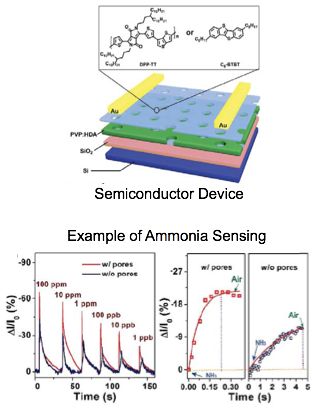
|
Drs. Cunningham and Bashir have developed a novel point of care diagnostic device capable of detecting pathogen infection from a single drop of blood. A blood sample is... Drs. Cunningham and Bashir have developed a novel point of care diagnostic device capable of detecting pathogen infection from a single drop of blood. A blood sample is channeled through a microfluidics device allowing amplification of viral DNA/RNA of interest, which is then detected using a uses smartphone. Infection information is then uploaded allowing tracking of infections geographically.
Immediate uses for the technology are for diagnosis of viral infection in human patients (Zika, dengue, and Chikungunya) and diagnosis of respiratory infection in equine populations (Equine herpesvirus, Equine influenza, Strangles, Equine adenovirus type 1, and Equine arteritis virus). Further uses include water testing, food safety, and pharmaceutical quality control.
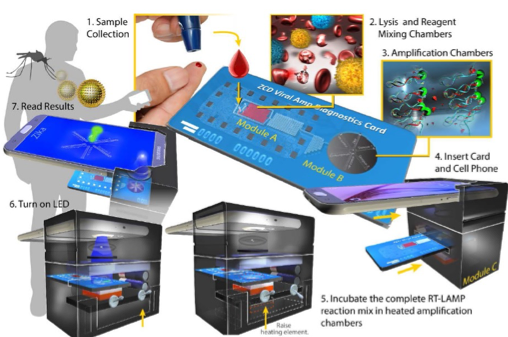 |
Professor Gaurav Bahl from the University of Illinois at Urbana-Champaign has developed a device that performs real-time high sensitivity acoustic sensing of flowing fluid... Professor Gaurav Bahl from the University of Illinois at Urbana-Champaign has developed a device that performs real-time high sensitivity acoustic sensing of flowing fluid-suspended cells and particles using ultra-high-Q microfluidic opto-mechanical resonators (OMFRs). They aim to achieve throughput rate of 50,000 cells/second. Related Publications: |
While nanopore sequencers available in the DNA sequencing industry are capable of detecting the presence of proteins in DNA strands, they are currently unable to identify... While nanopore sequencers available in the DNA sequencing industry are capable of detecting the presence of proteins in DNA strands, they are currently unable to identify specific proteins that are present. To solve this, Professor Leburton has developed a matched filter algorithm to classify particular epigenetic markers. The algorithm’s novel sensor technology detects and maps regions of hyper- and hypo-methylations across the genome using genetic markers. By calculating electrical current signatures of proteins and comparing them to other current signatures, it identifies the type of protein that exists on the DNA strand. The technology, which can be implemented onto existing hardware, is programmable to identify any protein. Integrating a sensor with signal processing architectures could pave the way to developing a multipurpose technology for early disease detection. 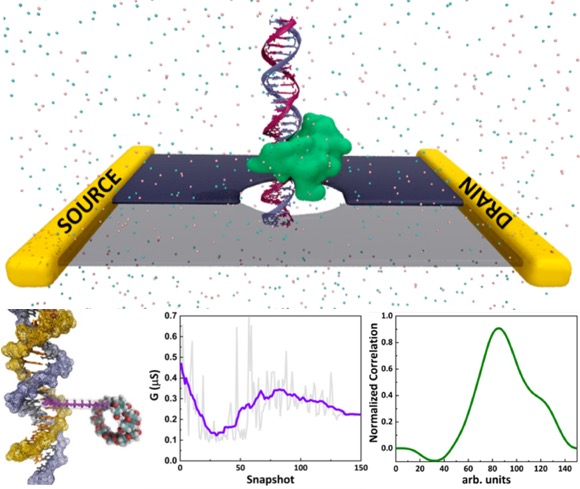
|
A scalable device design of a dense array of multiple 2D nanopores made from nanoscale semiconductor materials to simultaneously detect multiple DNA strands and identify... A scalable device design of a dense array of multiple 2D nanopores made from nanoscale semiconductor materials to simultaneously detect multiple DNA strands and identify translocations of many biomolecules in a massively parallel detection scheme. The technology is based on the variation of the transverse sheet current across each membrane. The electronic sensing across the nanopore membrane offers a higher detection resolution compared to ionic current blocking technique in a multi-pore setup, irrespective of the irregularities that occur while fabricating the nanopores in a 2D membrane. 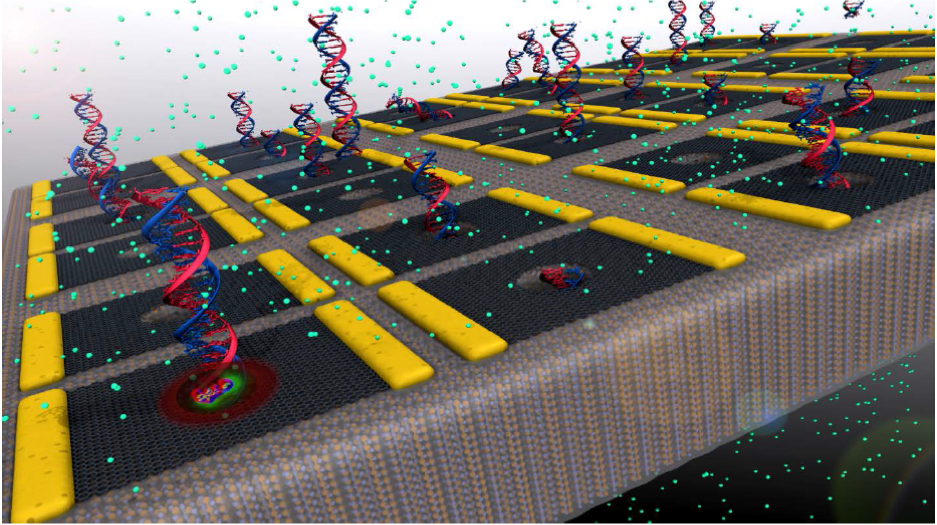
|
Professor Yi Lu from the University of Illinois has developed an aptamer-based method for virus detection that is able to distinguish infective viruses from non-infective... Professor Yi Lu from the University of Illinois has developed an aptamer-based method for virus detection that is able to distinguish infective viruses from non-infective virions at concentrations as low as 1 pfu/mL. This technology has been developed on human adenovirus but can be generalized to any virus of interest. Since it is not based on the sequencing of genetic information, it requires no sample preparation and can be completed in ~30 minutes. This technology has great potential utility for diagnostics and environmental testing, specifically water quality testing, for the identification and mitigation of water-borne illnesses including adenovirus.

|
Researchers from the University of Illinois have developed a highly sensitive, graphene field effect transistor (gFET) that can detect DNA in samples. This technology uses... Researchers from the University of Illinois have developed a highly sensitive, graphene field effect transistor (gFET) that can detect DNA in samples. This technology uses Loop-Mediated Isothermal Amplification (LAMP) and crumpled graphene in order to detect the presence of a target segment of DNA within a provided sample. By using crumpled graphene, gFET, and LAMP Dr. Ganguli's technology is able rapidly detect pathogens using entirely electronic means bringing diagnostics directly to point of care medical practice, all while being less expensive, more sensitive, and quicker than other traditional, gold-standard pathogen diagnostics methods. This technology is even able to detect molecular concentrations down to 8 zeptomolar. Publication: Ganguli, A., Faramarzi, V., Mostafa, A., Hwang, M. T., You, S., & Bashir, R. (2020). High Sensitivity Graphene Field Effect Transistor-Based Detection of DNA Amplification. Advanced Functional Materials, 30(28), [2001031]. https://doi.org/10.1002/adfm.202001031 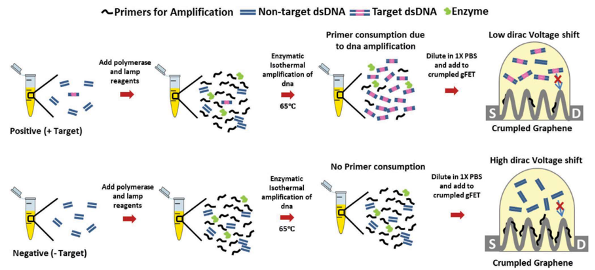
|
Professor Brian Cunningham's research group at the University of Illinois has created a technology for ultrasensitive detection of gold nanoparticles, allowing different... Professor Brian Cunningham's research group at the University of Illinois has created a technology for ultrasensitive detection of gold nanoparticles, allowing different assays and applications. These single step, isothermal, room temperature, one-pot assays can process a sample volume as low as ~20 ul. These assays are performed with an inexpensive, small device based on a low intensity LED (no laser), that allows for simple data quantification by counting (no fancy imaging sensor needed) and multiplexing by sample splitting. Applications of this technology include: - Activate Capture and Digital Counting (AC+DC) for detection of miRNA, based on gold nanoparticles tags prepared with DNA toehold probes (DNA-AuNPs). (LOD = 100 aM, 2h; no purification and amplification required)
- Activate Capture and Digital Counting (AC+DC) for detection of proteins, based on secondary antibody-functionalized gold nanoparticles (2oAb-AuNPs) within 15 min (LOD = 10pg/ml) (pictured below)
- Targeting Recycling Amplification Process (TRAP) for miRNA detection, based on strand displacement reactions (LOD = 0.1aM, 20 min)
- Activate Cleve and Count (ACC) for ctDNA detection based on gold nanoparticles released after target recognition by CRISPR/Cas (LOD = 1zM, 60 min) (pictured below

Related Technology: Photonic Resonator Absorption Microscopy (PRAM) Recent scientific publications include:
Other articles:
|
Researchers from the University of Illinois have developed a COVID-19 testing system named SPOT that consists of a rapid, highly sensitive and accurate assay and a battery... Researchers from the University of Illinois have developed a COVID-19 testing system named SPOT that consists of a rapid, highly sensitive and accurate assay and a battery-powered portable device. The assay combines RT-LAMP with an Argonaute protein from hyperthermophilic archaeon Pyrococcus furiosus for a precise recognition and cleavage of target DNA in saliva samples. The simplicity of the SPOT system enables rapid diagnosis of COVID-19 without a trained personnel and minimal sample handling. |
Researchers from the University of Illinois have developed a low-cost, reusable sensor for the detection of hydrogen peroxide. The sensor detects H2O2 over the range of... Researchers from the University of Illinois have developed a low-cost, reusable sensor for the detection of hydrogen peroxide. The sensor detects H2O2 over the range of biologically relevant concentrations (including as low as 0.016 uM) with sensitivity thresholds of up to 4903 uA mM-1 cm-2, with performance demonstrated in test solutions designed to mimic human blood. The device uses Bi2Te3 as its active material and can be fabricated at room temperature using conventional processes, making the sensors far less expensive than alternative commercial or pre-commercial solutions. 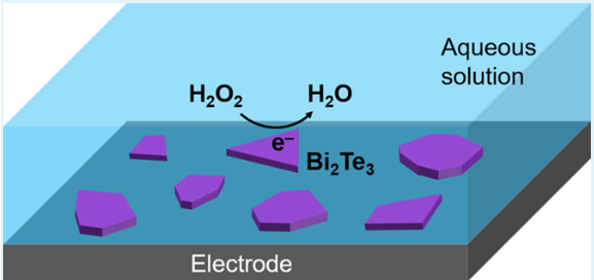
|
RT-PCR RNA based approaches, the most popular method for SARS-CoV-2 detection, are limited by large numbers of consumables and reagents required, the need for well-... RT-PCR RNA based approaches, the most popular method for SARS-CoV-2 detection, are limited by large numbers of consumables and reagents required, the need for well-optimized protocols, challenges with mutations, and RNA lingering after infectivity. Researchers at the University of Illinois, led by Dr. Aaron Timperman, have developed a protein-based rapid, reliable and inexpensive nanofluidic/microfluidic system to detect viral proteins with limits of detection at clinically relevant levels. The system receives a sample, purifies the virions, prepares the sample and sprays the sample directly into a mass spectrometry. This protein-based approach allows the collection of additional information such sequence mutations, modifications that affect protein function, and bound antibodies. 
|
Prof. Yurii Vlasov and Christopher Kenji Brenden from the University of Illinois have designed an electrochemical biosensor capable of detecting small concentrations of... Prof. Yurii Vlasov and Christopher Kenji Brenden from the University of Illinois have designed an electrochemical biosensor capable of detecting small concentrations of neurochemicals in vivo with high spatiotemporal resolution. The probe design include a thin-layer design with microfluidic channels to decrease probe size and improve the voltage-current response from electroactive biomolecules. Electrodes are placed within the microfluidic channels of the cell to prevent degradation of electrode surfaces by immune responses and attack by biological agents. Valve-free flow switching allows for in situ regeneration and calibration of the probe electrodes without removing the probe from the target biological tissue. This allows for longer measurements periods without experience large drift in electrochemical signals. |

